|
|
 |
Fiche d'espèce de Copépode |
|
|
Monstrilloida ( Ordre ) |
|
|
|
Monstrillidae ( Famille ) |
|
|
|
Caromiobenella ( Genre ) |
|
|
| |
Caromiobenella brasiliensis (Dias & Suarez-Morales, 2000) (F,M) | |
| | | | | | | Syn.: | Monstrilla brasiliensis Dias & Suarez-Morales, 2000 | | | | Ref.: | | | Suarez-Morales & Dias, 2000 (p.1034, Descr.F, figs.F); 2011 (p.8, 9) | 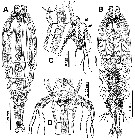 issued from : E. Suarez-Morales & C. Dias in J. mar. Biol. Ass. U.K., 2000, 80. [p.1035, Fig.3]. Female (from Baia do Espirito Santo: Brazil): A-B, habitus (dorsal and ventral, respectively); C, 5th pedigerous somite and genital double-somite (lateral; arrows indicate surface P5 button-like processes); D, idem (ventral). Nota: Head and 1st pedigerous somite fused, and 3 free succeeding pedigerous somites. Forehead with pair of short, slender sensillae. P5 elongated, with 2 distinct lobes, fused medially; outer lobe slender, about 1.2 times thicker than inner lobe one and slightly longer, armed with 3 long setae (setae with scattered setules); inner lobe slender, cylindrical, armed with 1 distal seta, in lateral view, base of inner lobe with 2 small, rounded cuticular protuberances (arrowed in fig.3C); P5 shows a conspicuous set of stout hair-like setae on the surface. Urosome consisting of 5th pedigerous somite, genital double-somite, and 2 free abdominal somites; urosome representing (excluding caudal rami) 21.7 % of total body length. Genital double-somite with short ovigerous spines, spines about 20.4 % of total body length, extending slightly beyond distal margin of caudal rami.
|
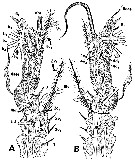 issued from : E. Suarez-Morales & C. Dias in J. mar. Biol. Ass. U.K., 2000, 80. [p.1036, Fig.4]. Female: A, left A1 (dorsal view); B, right A1 (dorsal view). Armament elements shown in terms of Grygier & Ohtsuka (1995) nomenclature. Nota: A1 between 40 and 45 % as long as cephalothorax and about 20 % of total body length; 3-segmented; ratio of length of segments 13.8:16.6:69.6 = 100; distal segment with setae b1-b3 simple, unbranched.
|
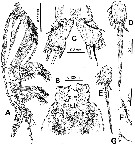 issued from : E. Suarez-Morales & C. Dias in J. mar. Biol. Ass. U.K., 2000, 80. [p.1037, Fig.5]. Female: A, habitus (lateral); B, cephalic region (ventral); C, caudal rami (dorsal); D, terminal segment of exopod of P4; E, idem for P1; F, basipodal lateral seta of P3; G, idem for P2. Nota: Caudal rami about 2 times longer than wide, moderately divergent, bearing 1 lateral, 1 outer, 3 terminal and 1 dorsal setae.
|
 issued from : E. Suarez-Morales & C. Dias in J. mar. Biol. Ass. U.K., 2000, 80. [p.1037]. Female: Armature of swimming legs P1 to P4. [Roman numeral = spine, arabic numeral = seta]
|
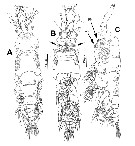 issued from : Cruz Lopes da Rosa J. da, Dias C.d.O., Suárez-Morales E., Weber L.I., & Fischer L.G. in Diversity, 2021, 13(6): 241. [p.6, Fig.2].
Male: Caromiobenella brasiliensis (Dias and Suárez-Morales, 2000) comb. nov., from Rio de Janeiro area, adult male (MNRJ30136). (A) Habitus, dorsal view; (B) Habitus, lateral view; (C) Same, ventral view. Arrows indicate antero-ventral nipple-like cuticular processes. Legend: pp = preoral process, op = oral papilla.
|
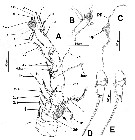 issued from : Cruz Lopes da Rosa J. da, Dias C.d.O., Suárez-Morales E., Weber L.I., & Fischer L.G. in Diversity, 2021, 13(6): 241. [p.7, Fig.3].
Male: Caromiobenella brasiliensis (Dias and Suárez-Morales, 2000) comb. nov., from Rio de Janeiro area, adult male
(MNRJ30136). (A) Right antennule, dorsal view showing setal elements (segments 1–4 [14], segment 5 [1]; (B) Left fifth antennulary segment; (C) Anterior part of cephalothorax, lateral view (pp = preoral process, op = oral papilla); (D) Leg 1 exopod; (E) Leg 3 exopod. Arrow indicates wrinkled outer process on second segment. Legend: pp = preoral process,op = oral papilla.
|
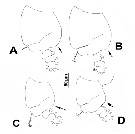 issued from : Cruz Lopes da Rosa J. da, Dias C.d.O., Suárez-Morales E., Weber L.I., & Fischer L.G. in Diversity, 2021, 13(6): 241. [p.9, Fig.4].
Male: Caromiobenella brasiliensis (Dias and Suárez-Morales, 2000) comb. nov., from Rio de Janeiro area, adult male (MNRJ30136). (A) Leg 1; (B) Leg 2; (C) Leg 3; (D) Leg 4. Arrows indicate expanded inner margins of basipod.
| | | | | Ref. compl.: | | | Dias & Bonecker, 2007 (p.270, 272, fig.3, tab.II); Oliveira Dias & al., 2008 (p.248, tab.1) | | | | NZ: | 1 | | |
|
Carte de distribution de Caromiobenella brasiliensis par zones géographiques
|
| | | | Loc: | | | Brazil (Salvador-Rio de Janeiro, Rio Grande do Norte).
Brazil Camburi, Baía do Espírito Santo (Rio de Janeiro coast) 20°16.3830' S, 40°15.9000' W | | | | N: | 2 | | | | Lg.: | | | (843) F: 2,0-2,78; 2,81-3,01*; (997) F: 2,2*; (1327) F: 2,08-2,35; M: 0,816-1,170; {F: 2,08-3,01; M: 0,816-1,170}
*: caudal rami excluded. | | | | Rem.: | According to Suarez-Morales & Dias (2000, p.1038) this species can easily be distinguished from all the other known species of Monstrilla by the peculiar structure of P5, which shows a conspicuous set of stout hair-like setae on the surface of the legs; this species shares with M. inserta (type material from the Siboga Expedition) the peculiar A1 structure (among others the presence of the two structures on the base, this enigmatic struture has not been reported in the Monstrilloida), the body proportions, the length of the ovigerous spines, and the general structure of P5.
Cruz Lopes da Rosa J. da & al (2021) new zooplankton collections in coastal waters and intertidal rocky pools of the SWA yielded several male and female monstrilloid copepods tentatively identified as Monstrilla brasiliensis. their results of both morphologic and molecular (mtCOI) analyses allowed them to confirm that these males and females were conspecific. They also found evidence suggesting that Caromiobenella is not a monophyletic taxon. Their male specimens are morphologically assignable to Caromiobenella, therefore, females of the nominal species Monstrilla brasiliensis, are matched here with the aforementioned males and, thus, the species should be known as C. brasiliensis comb. nov. (Dias and Suárez-Morales, 2000).
This species belongs to the new genus Caromiobenella, therefore it is a comb. nov.
| | | Dernière mise à jour : 08/01/2025 | |
|
|
 Toute utilisation de ce site pour une publication sera mentionnée avec la référence suivante : Toute utilisation de ce site pour une publication sera mentionnée avec la référence suivante :
Razouls C., Desreumaux N., Kouwenberg J. et de Bovée F., 2005-2025. - Biodiversité des Copépodes planctoniques marins (morphologie, répartition géographique et données biologiques). Sorbonne Université, CNRS. Disponible sur http://copepodes.obs-banyuls.fr [Accédé le 23 octobre 2025] © copyright 2005-2025 Sorbonne Université, CNRS
|
|
 |
 |









